Imagine steering a company from the textile world into becoming a global leader in the automotive industry. This is the inspiring journey of the Toyota CEO. The story begins with founders who dreamed big and laid the groundwork for innovation and quality.
From there, each CEO adapted to changing times, leading Toyota through market shifts and technological advancements. This evolution is not just about cars; it’s about a legacy of leadership that shapes the future. Dive into the remarkable saga of Toyota’s leadership, where visionaries turned challenges into opportunities, making Toyota a testament to resilience and foresight.
A Brief History of Toyota CEO
The leadership journey of Toyota is a fascinating tale that showcases the evolution of a company from its roots in the textile industry to becoming a leader in the automotive world.
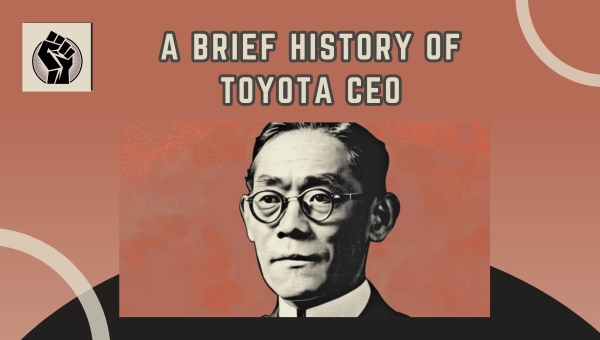
The story of Toyota’s CEOs is a testament to their vision, adaptability, and commitment to excellence. From the pioneering leadership of its founders to the strategic innovations by successive CEOs, Toyota’s history is rich with lessons in resilience and growth.
Founding Leadership
The foundation of Toyota was laid by visionaries Kiichiro Toyoda and his father, Sakichi Toyoda. Their leadership was crucial in transitioning from textiles to automobiles. Kiichiro’s entrepreneurial spirit and focus on innovation were instrumental in setting the stage for Toyota’s future success.
They emphasized the importance of quality and continuous improvement, principles that have become synonymous with Toyota. Their vision was not just about creating vehicles but also about establishing a culture of respect and excellence.
Evolution Over the Decades
As decades passed, Toyota’s leaders faced the challenge of adapting to changing market demands and technological advancements. Each Toyota CEO brought unique strategies to the table, ensuring the company remained competitive.
They embraced lean manufacturing principles, which revolutionized efficiency and quality. Moreover, the investment in hybrid technology marked a significant shift towards sustainability. This evolution reflects Toyota’s ability to remain resilient and innovative, even as the automotive landscape transformed rapidly.
Key Historical Milestones
Toyota has witnessed numerous pivotal moments, thanks to its visionary CEOs. Here are some highlights that defined its journey:
- 1937: Establishment of Toyota Motor Corporation, marking its entry into the automotive industry.
- 1950s: Introduction of the Toyota Production System (TPS), setting a new standard in manufacturing efficiency.
- 1997: Launch of the Prius, the world’s first mass-produced hybrid vehicle, showcasing Toyota’s commitment to innovation.
- 2008: Achieving the status of the largest automaker in the world by sales, a remarkable achievement reflecting its global influence.
These milestones are not just dates; they are landmarks that have shaped the automotive industry and solidified Toyota’s position as a leader.
Also Read: Ford CEOs – Comprehensive Leader Timeline
Notable Toyota CEOs & Presidents and Their Contributions
Toyota has been shaped by a series of influential leaders who have each left a significant mark on the company’s history.
Here, we explore their contributions in detail.
1. Kiichiro Toyoda (1937-1950)
Kiichiro Toyoda, the founder of Toyota Motor Corporation, served as its first president from 1937 until his death in 1952. Under his leadership, Toyota transitioned from a textile manufacturer to an automobile producer. He spearheaded the development of the first passenger car, the Model AA, in 1936, which marked the company’s entry into the automotive market.
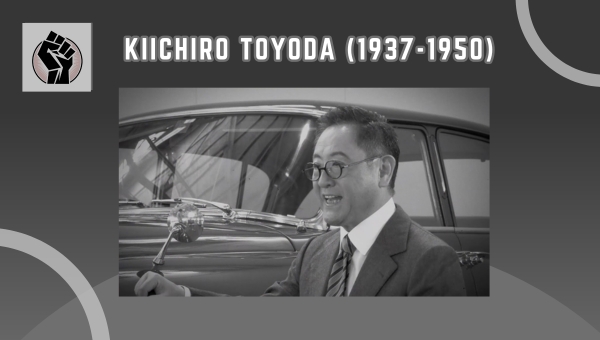
Kiichiro’s vision emphasized innovation and quality, laying the groundwork for what would become the Toyota Production System (TPS). His commitment to continuous improvement and respect for people established a culture that would define Toyota’s operations for decades.
2. Taizo Ishida (1950-1961)
Taizo Ishida took over as president following Kiichiro Toyoda’s tenure. His leadership was marked by significant expansion and modernization of Toyota’s production capabilities. Ishida focused on improving manufacturing processes and increasing vehicle production to meet growing demand in post-war Japan.

He also played a crucial role in establishing Toyota’s export strategy, which helped the company gain a foothold in international markets. His efforts laid the foundation for Toyota’s future global expansion.
3. Fukio Nakagawa (1961-1967)
Fukio Nakagawa served as president during a transformative period for Toyota. He oversaw the introduction of several key models that would define the brand, including the Corolla in 1966, which became one of the best-selling cars globally.
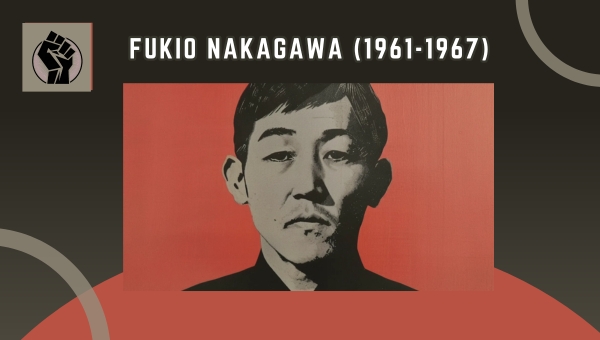
Nakagawa emphasized quality control and operational efficiency, further refining TPS principles. His leadership helped Toyota establish a reputation for reliability and affordability, crucial factors that contributed to its success in both domestic and international markets.
4. Eiji Toyoda (1967-1982)
Eiji Toyoda, cousin to Kiichiro Toyoda, became president in 1967 and led Toyota through a period of remarkable growth and innovation. He expanded production facilities both domestically and internationally, including establishing manufacturing plants in North America.

Eiji was instrumental in developing TPS into a comprehensive manufacturing philosophy that emphasized waste reduction and efficiency. His leadership during the oil crisis of the 1970s positioned Toyota as a leader in fuel-efficient vehicles, paving the way for future innovations such as hybrid technology.
5. Shoichiro Toyoda (1982-1992)
Shoichiro Toyoda, another member of the founding family, served as president during a time when Toyota faced intense global competition. He focused on enhancing product quality and customer satisfaction, leading to significant improvements in manufacturing processes.
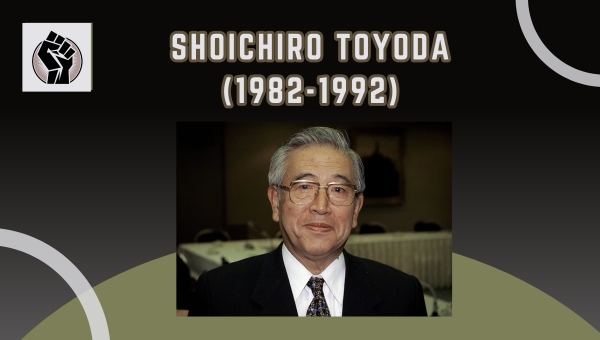
Under his guidance, Toyota launched several successful models, including the Lexus brand in 1989, which aimed to compete with luxury automakers. Shoichiro’s emphasis on quality management helped solidify Toyota’s reputation as a leader in automotive excellence.
6. Tatsuro Toyoda (1992-1995)
Tatsuro Toyoda continued the legacy of his predecessors by focusing on global expansion and technological advancement during his presidency. He oversaw the launch of new models that catered to diverse markets and consumer preferences.
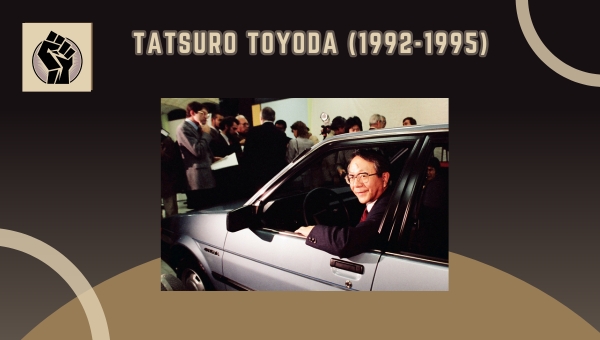
Tatsuro emphasized innovation in vehicle design and production methods, further enhancing TPS principles to adapt to changing market conditions. His leadership helped maintain Toyota’s competitive edge during a challenging economic environment.
7. Hiroshi Okuda (1995-1999)
Hiroshi Okuda served as president during a period marked by globalization and increased competition from foreign automakers. He focused on strengthening Toyota’s global presence by expanding operations in emerging markets and enhancing supply chain management.

Okuda was instrumental in promoting collaborative partnerships with other manufacturers, which allowed Toyota to leverage new technologies and improve efficiency across its operations.
8. Fujio Cho (1999-2006)
Fujio Cho took over as president at a time when Toyota was facing challenges related to quality control issues and increased competition from rivals like Honda and Nissan. His leadership emphasized restoring consumer confidence through rigorous quality improvement initiatives.

Cho also championed sustainability efforts within the company, leading to advancements in hybrid technology with models like the Prius becoming mainstream vehicles during his tenure.
9. Katsuaki Watanabe (2005-2009)
Katsuaki Watanabe succeeded Fujio Cho during a critical phase for Toyota as it sought to expand its hybrid vehicle lineup while maintaining its reputation for quality. Watanabe focused on enhancing environmental sustainability initiatives and increasing production capacity for hybrid models.

His leadership was marked by strategic investments in research and development aimed at advancing alternative fuel technologies.
10. Akio Toyoda (2009-2023)
Akio Toyoda has been at the helm since 2009, guiding the company through numerous challenges including financial crises and natural disasters such as the 2011 earthquake and tsunami in Japan.
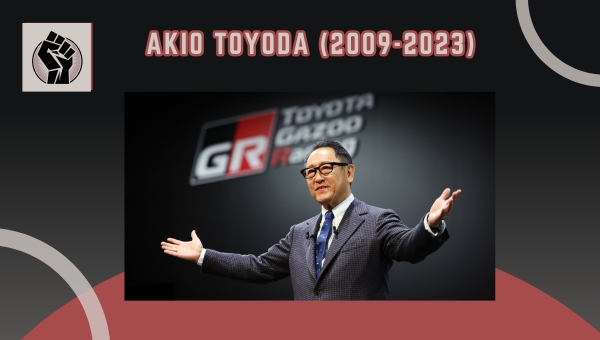
His leadership has been characterized by a strong focus on innovation, customer satisfaction, and sustainability initiatives aimed at reducing carbon emissions across Toyota’s product line. Akio has also prioritized digital transformation within the company, positioning Toyota as a leader in connected vehicles and mobility solutions.
11. Kōji Satō (2023-present)
Kōji Satō became CEO on April 1, 2023, succeeding Akio Toyoda. With a background in engineering and extensive experience within various divisions at Toyota, Satō aims to continue advancing Toyota’s commitment to sustainability.
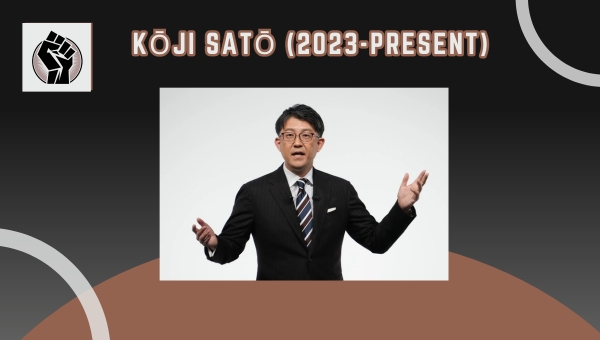
He will navigate challenges posed by electric vehicle competition and changing consumer preferences. His leadership is expected to focus on further enhancing product development strategies while maintaining Toyota’s core values of quality and innovation.
Each of these leaders has played an essential role in shaping Toyota’s identity as one of the world’s foremost automotive manufacturers, contributing uniquely to its legacy through its vision, strategic decisions, and commitment to excellence.
Leadership Style and Philosophy of Toyota CEO
The leadership style and philosophy of the Toyota CEO have consistently been a driving force behind the company’s success. At the heart of this philosophy is a commitment to continuous improvement and respect for people, which has shaped Toyota’s corporate culture.
With a focus on innovation, quality, and market adaptability, Toyota’s leadership team has ensured that the company remains at the forefront of the automotive industry.
Focus on Innovation
Toyota CEOs have always placed a high priority on innovation to maintain a competitive edge in the automotive sector. This focus has resulted in significant advancements, such as the development of hybrid technology and the exploration of autonomous vehicles.
By investing in research and development, Toyota has introduced groundbreaking technologies that set new standards in the industry. Innovation is not just about creating new products; it is about improving processes and enhancing the overall customer experience.
Commitment to Quality
Quality and reliability are cornerstones of Toyota’s leadership philosophy. This dedication is reflected in the company’s adherence to the ‘Toyota Way’ principles, which emphasize:
- Continuous Improvement (Kaizen): Encouraging incremental improvements in all areas of the business.
- Respect for People: Valuing the contributions of each employee and promoting teamwork.
- Customer First: Ensuring that customer needs and satisfaction are prioritized in every decision.
These principles have helped Toyota build a reputation for producing vehicles that are dependable and long-lasting, which in turn has earned the trust of consumers worldwide.
Adaptation to Market Trends
Adapting to changing market trends is essential for any business, and Toyota CEOs have skillfully navigated these shifts.
They have implemented strategies to address global challenges and seize new opportunities, such as:
- Expanding into Electric Vehicles (EVs): Aligning with consumer preferences for environmentally friendly transportation.
- Investing in Autonomous Driving Technologies: Positioning Toyota as a leader in the future of mobility.
- Enhancing Supply Chain Resilience: Ensuring stability and efficiency even amid disruptions.
Through these strategies, Toyota has remained agile and responsive to the dynamic landscape of the automotive industry, positioning itself for continued growth and success.
Also Read: Uber CEO History: A Journey of Leadership
Challenges Faced by Toyota CEOs
Navigating the complex landscape of the global automotive industry, Toyota CEOs have encountered several formidable challenges. These have tested their resilience and strategic acumen.

From economic upheavals to fierce competition and the rising demand for sustainability, each CEO has played a pivotal role in steering the company through turbulent times.
Economic Crises
Toyota’s leadership has tackled significant financial challenges throughout its history. During periods of global economic downturns, strategic measures were essential to ensure stability.
- In the 2008 financial crisis, Toyota implemented cost-cutting initiatives while maintaining its commitment to quality.
- During the COVID-19 pandemic, the company adapted production strategies to safeguard employees and meet fluctuating demand.
- Leveraging flexible manufacturing to quickly adjust to changing market conditions.
Competition in the Automotive Industry
The competitive pressures within the automotive sector have been persistent, with Toyota CEOs needing to remain vigilant against global competitors.
- Innovating product lines to rival electric vehicle manufacturers like Tesla.
- Enhancing marketing and brand loyalty strategies to retain and grow the customer base.
- Continuously advancing technology to stay competitive in the evolving market landscape.
Environmental and Regulatory Challenges
Addressing the increasing call for sustainability and adherence to stricter regulations has been another significant challenge for Toyota CEOs. They have spearheaded numerous initiatives aimed at environmental responsibility.
- Committing to achieving carbon neutrality by 2050.
- Expanding hybrid and hydrogen fuel cell vehicle offerings such as the Mirai.
- Implementing sustainable practices across manufacturing processes to reduce environmental impact.
Toyota’s leadership has consistently demonstrated adaptability and foresight in overcoming these challenges, ensuring the company’s continued success and leadership within the automotive industry.
Impact of Toyota CEO’s on the Automotive Industry
Toyota’s leadership has long shaped the automotive landscape, setting benchmarks for quality and innovation. The influence of its CEOs extends beyond mere business practices, impacting global manufacturing standards and consumer expectations.
Setting Industry Standards
Toyota CEOs have been instrumental in revolutionizing global manufacturing practices. Their introduction of the Toyota Production System (TPS) is a pivotal development. This system, known for its efficiency and waste reduction, has become a model for lean manufacturing across the industry.
By focusing on continuous improvement and respect for workers, Toyota’s approach has influenced countless companies worldwide, fostering a culture of excellence and innovation.
Driving Sustainability
Toyota has taken a leading role in advocating for sustainability within the automotive industry. Under the guidance of its CEOs, the company has made significant strides in hybrid technology and sustainable solutions.
Key advancements include:
- Prius: The introduction of the Prius marked the world’s first mass-produced hybrid vehicle, setting the stage for the widespread adoption of environmentally friendly cars.
- Mirai: As a pioneer in hydrogen fuel cell technology, the Mirai exemplifies Toyota’s commitment to alternative energy sources, promoting cleaner transport options.
Influencing Consumer Trends
Toyota CEOs have consistently shaped consumer preferences by delivering vehicles that prioritize affordability, reliability, and innovation.
Their strategic focus on these elements has resulted in several influential models:
- Camry: Known for its durability and cost-effectiveness, the Camry has become a household name for those seeking a dependable vehicle.
- Corolla: This model emphasizes affordability without compromising on quality, appealing to budget-conscious consumers.
- RAV4: By integrating modern technology and design, the RAV4 has captured the interest of consumers looking for a blend of innovation and practicality.
Toyota’s leadership continues to drive the company forward, ensuring it remains at the forefront of the automotive industry.
FAQs
Who is the owner of the Toyota company?
Toyota is a publicly traded company, so it is owned by its shareholders. The largest shareholders are typically institutional investors and individual stockholders.
Who was the founder of Toyota?
Toyota was founded by Kiichiro Toyoda. He transitioned the company from its roots in the textile industry to become a major player in the automotive sector.
How have Toyota CEOs influenced the rise of hybrid and electric vehicles?
Toyota CEOs have been proactive in promoting hybrid and electric vehicle technology. Their leadership has led to the development and widespread adoption of models like the Prius, which set a global standard for hybrid cars.
Conclusion
The evolution of the Toyota CEO role highlights a journey of innovation, resilience, and adaptation. Each leader has contributed uniquely to shaping the company’s path, ensuring Toyota remains at the forefront of the automotive industry. From pioneering hybrid technology to setting benchmarks in manufacturing, Toyota’s leadership is a testament to its commitment to quality and excellence.
As the company continues to face new challenges and opportunities, the legacy of its CEOs will undoubtedly guide its future endeavors. If you enjoyed this exploration of Toyota’s leadership story, be sure to check out more insightful articles on our site for further reading.





